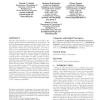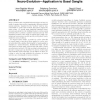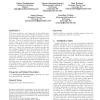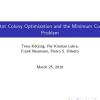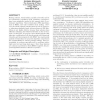110
click to vote
GECCO
2010
Springer
15 years 5 months ago
2010
Springer
This study proposes a simple computational model of evolutionary learning in organizations informed by genetic algorithms. Agents who interact only with neighboring partners seek ...
94
Voted
GECCO
2010
Springer
15 years 5 months ago
2010
Springer
In this paper, we compare the (1+1)-CMA-ES to the (1+2s m)CMA-ES, a recently introduced quasi-random (1+2)-CMAES that uses mirroring as derandomization technique as well as a sequ...
118
click to vote
GECCO
2010
Springer
15 years 5 months ago
2010
Springer
We report the formulation and implementation of a genetic algorithm to address multi-objective optimisation of solar gain to buildings with the goal of minimising energy consumpti...
61
Voted
GECCO
2010
Springer
15 years 5 months ago
2010
Springer
117
click to vote
GECCO
2010
Springer
15 years 5 months ago
2010
Springer
For many large-scale combinatorial search/optimization problems, meta-heuristic algorithms face noisy objective functions, coupled with computationally expensive evaluation times....
115
Voted
GECCO
2010
Springer
15 years 5 months ago
2010
Springer
Neuro-evolution and computational neuroscience are two scientific domains that produce surprisingly different artificial neural networks. Inspired by the “toolbox” used by ...
GECCO
2010
Springer
15 years 5 months ago
2010
Springer
The Hypercube-based NeuroEvolution of Augmenting Topologies (HyperNEAT) approach demonstrated that the pattern of weights across the connectivity of an artificial neural network ...
104
Voted
GECCO
2010
Springer
15 years 5 months ago
2010
Springer
This paper presents a novel approach for knowledge mining from a sparse and repeated measures dataset. Genetic programming based symbolic regression is employed to generate multip...
GECCO
2010
Springer
15 years 5 months ago
2010
Springer
GECCO
2010
Springer
15 years 5 months ago
2010
Springer
Niching schemes, which sustain population diversity and let an evolutionary population avoid premature convergence, have been extensively studied in the research field of evoluti...


